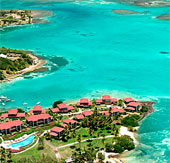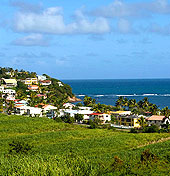Loi Girardin pushes prices up

Martinique is one of France's two Caribbean 'overseas departments' (DOMs) (Guadeloupe is the other one). Departments are integral parts of the French Republic. French taxes apply, and French citizenship rights are given.
The Departments send representatives to the National Assembly, the Senate, and elect a member of the European Parliament (Martinique is now represented in the French parliament by four deputies and two senators). They also use the Euro as their currency.
Almost all housing built in the DOMs is subsidized under the Loi Girardin, which allows 40% of a DOM-located property purchase cost to be written off against future tax payments (the parallel incentive in metropolitan France is the Loi De Robien). Such incentives have spurred an entire industry of financial consultants advising on 'defiscalisation'.
"One result of the Loi Girardin is that prices have gone astronomical," says Douglas Rapier of Atout Immobilier in Fort de France Martinique. In the past three years, he estimates, real estate prices have risen by around 20%. In fact average prices have risen above the maximum Loi Girardin limit of €2,025 per sq. m on the interior living area (which includes 14 sq. m. of balcony). "Prices here have gone above the capacity of ordinary people to bear."
Land prices have also greatly risen, typically to over €150 per sq. m in Martinique. Land has become very scarce in Fort de France and Lamentin, Matinique's main business areas, and in Trois Islets and Point du Bourg, the tourist areas.
Wealthy US tourists

Martinique and Guadeloupe are trying to attract more wealthy US tourists who can pay these large-house rents, partly because the yields achievable are higher. Martinique is preparing itself: Its beautiful marina is already giving staff English lessons.
But a change in attitude is required. Few people in Martinique speak English. Planning for the US market means developing the right kind of luxury house, developing the right attitudes, and having overseas marketing.
"We have here family-type houses with master bedrooms, plus two bedrooms with a shared shower," says Rapier.
"Well, the US market wants something different. They want all the rooms to be suitable for couples, who desire privacy.
"People here are not at all familiar with the international environment. For instance, US people - they need a response in 24 hours. And people here need someone who can provide the marketing."
Falling rentals
Martinique rentals are falling because so many new houses have been put on the market over the past 10-15 years. This is a kind of a success, because it means that the Loi Girardin has achieved its purpose of injecting money in and greatly increasing the supply of housing.
But it is not much fun for landlords. "Nine years ago when we started (I came to Martinique in 1995) when I told owners they would have to pay commission to rent their property, they would just laugh!" says Rapier.
"Now renters of old properties face real difficulty in renting property. This is the direct result of the defiscalisation laws."